![]()
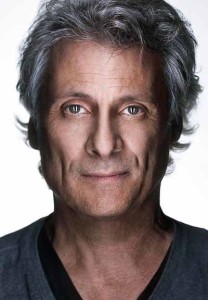
Black Mass is based upon the true story of hit man Whitey Bulger (Johnny Depp). The whole film gave the impression of things being striped away to lay bare a gritty ugliness that comes across as almost normal. The biggest challenges Mangini faced were to have the film soundtrack designed so that everything that is heard had intention, just like everything that is seen. Nothing is accidental, however simple it may appear to be.
“One of Scott’s mandates was never let sound draw attention to itself, and this is what he said to the DP, the production designers and costume designers about their work,” shared Mangini. “He wanted the audience to actually experience those moments as if they were really there. That takes a certain amount of restraint.”
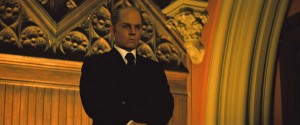
“The guns, in respect to the killings, were small, but it made it bigger because it sounded so real. It made it more frightening actually because it was so mundane,” explained Mangini.
Every one of the killings was designed in a very real way, especially the strangling of Juno (Deborah Hussey). A subtly stylized choice was made in the mix to leach out the sounds of her struggling once the camera panned away from the act of strangulation, and focus on the somber cello line in Tom Holkenborg’s score when the camera pushed into Flemmi’s face as he’s watching the murder of the girl he’d been sleeping with.
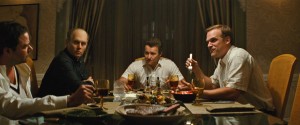 “We kept those sounds very real at first. There’s a very powerful grab and then some choking sounds, the sounds of her kicking her feet. All of that was fabricated in postproduction to make it sound visceral and nasty and really make you want to cringe for a moment,” revealed Mangini. “Then we allowed a transition to occur as we focused on Flemmi, and let the audience wonder – without hitting them over the head any further with death sounds – what’s he feeling at this moment?”
“We kept those sounds very real at first. There’s a very powerful grab and then some choking sounds, the sounds of her kicking her feet. All of that was fabricated in postproduction to make it sound visceral and nasty and really make you want to cringe for a moment,” revealed Mangini. “Then we allowed a transition to occur as we focused on Flemmi, and let the audience wonder – without hitting them over the head any further with death sounds – what’s he feeling at this moment?”
The only other stylized scene in the movie, where the team did not use real sound, was in the nightclub sequence where the audience begins to suspect that something is up. Visually the viewer is bombarded with flashy disco strobe lights. Anticipating the attack on Callahan, Mangini turned those flashing strobe light sounds into flak and artillery explosions.
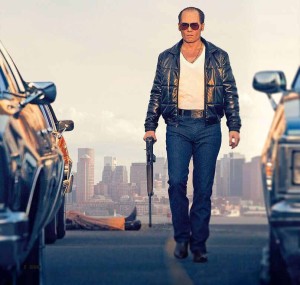 “That was a fun sonic transition as we head towards the reveal that he’s been shot in the Cadillac and is dead in the trunk. It was like a siege. We used un-realistic sounds. Probably the only scene that we used un-realistic sound in,” noted Mangini.
“That was a fun sonic transition as we head towards the reveal that he’s been shot in the Cadillac and is dead in the trunk. It was like a siege. We used un-realistic sounds. Probably the only scene that we used un-realistic sound in,” noted Mangini.
Many of the hard effects used in the film were recorded by Mangini. For the scene near the beginning of the film where the big Italian is beaten up, the sound team recorded the sounds of struggle in an old ’60s American car and the sounds of punching. With uncompromising dedication, Mangini joked that he got black and blue for his art recording these hits by punching his own face and leg so the sound was fist on skin.
“No fabricated watermelon smashes. None of the usual sound tropes we use for those kinds of sound effects. I wanted to do that at the risk of a non-heightened reality,” said Mangini. “It was just all the real thing so that you could feel like you’d want to cringe. That guy really got wacked!”
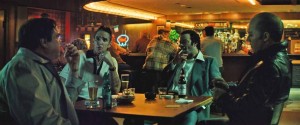 The other important element in the creation of a film soundtrack is between music. The collaboration between sound designer and composer during a mix can sometimes be contentious with each fighting for audio prominence in a scene. This was not the case with Mangini and Holkenborg.
The other important element in the creation of a film soundtrack is between music. The collaboration between sound designer and composer during a mix can sometimes be contentious with each fighting for audio prominence in a scene. This was not the case with Mangini and Holkenborg.
Mangini related that he had worked with the composer on Mad Max: Fury Road, “We developed a wonderful relationship built around drinking coffee and our love of music. I’m a musician myself. We would lament that it was sort of a tragedy that our departments didn’t spend a lot of time working together because we would ultimately have to share the same soundtrack. During Fury Road, we developed this notion that would begin some time in the future – not knowing Black Mass would come up – we would start sharing our work with each other.”
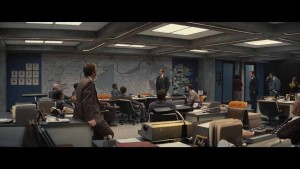 When Black Mass started, the two implemented the plan. Within a week of the composer coming onto the film the two departments shared “palettes,” sound and music elements that they were going to use on the soundtrack. The idea was for the composer to use sounds in a musical way, while the designer used them in a non-musical way.
When Black Mass started, the two implemented the plan. Within a week of the composer coming onto the film the two departments shared “palettes,” sound and music elements that they were going to use on the soundtrack. The idea was for the composer to use sounds in a musical way, while the designer used them in a non-musical way.
“In the process we would find this very elegant and seamless co-habitation of the soundtrack,” Mangini explained. “Sometimes I wasn’t quite sure if it was a sound effect moment or a music moment, but to us it didn’t matter. It was all part of the approach to the movie and that worked beautifully. That was a really successful process for us.”
Mangini employed a similar process with the picture editor. He had the luxury of being on the film for over six months, a long period during which he was able to pass effects to picture editorial to try out in the edit – a process of trial and elimination. This manner of working also informed the edit by making scenes come alive in ways that were not anticipated.
“It’s been said that filmmaking is like pointillism in painting. It’s made up of thousands and thousands of individual ideas and colors all of which create a whole. Any moment a point is missing, there is something flawed about the final product,” Mangini surmised.





